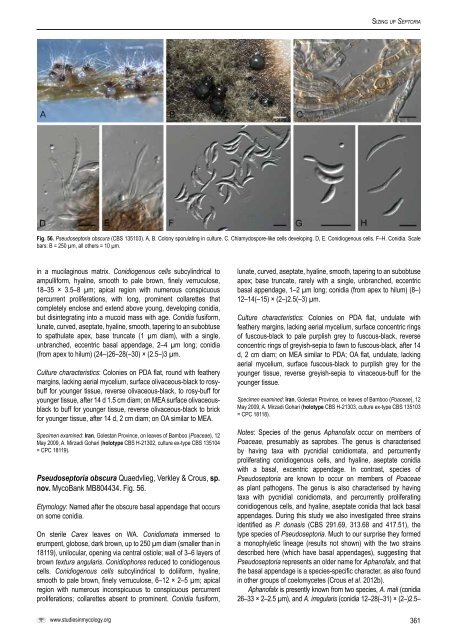Phytopathogenic Dothideomycetes - CBS - KNAW
Phytopathogenic Dothideomycetes - CBS - KNAW
Phytopathogenic Dothideomycetes - CBS - KNAW
You also want an ePaper? Increase the reach of your titles
YUMPU automatically turns print PDFs into web optimized ePapers that Google loves.
Sizing up Septoria<br />
Fig. 56. Pseudoseptoria obscura (<strong>CBS</strong> 135103). A, B. Colony sporulating in culture. C. Chlamydospore-like cells developing. D, E. Conidiogenous cells. F–H. Conidia. Scale<br />
bars: B = 250 µm, all others = 10 µm.<br />
in a mucilaginous matrix. Conidiogenous cells subcylindrical to<br />
ampulliform, hyaline, smooth to pale brown, finely verruculose,<br />
18–35 × 3.5–8 µm; apical region with numerous conspicuous<br />
percurrent proliferations, with long, prominent collarettes that<br />
completely enclose and extend above young, developing conidia,<br />
but disintegrating into a mucoid mass with age. Conidia fusiform,<br />
lunate, curved, aseptate, hyaline, smooth, tapering to an subobtuse<br />
to spathulate apex, base truncate (1 µm diam), with a single,<br />
unbranched, eccentric basal appendage, 2–4 µm long; conidia<br />
(from apex to hilum) (24–)26–28(–30) × (2.5–)3 µm.<br />
Culture characteristics: Colonies on PDA flat, round with feathery<br />
margins, lacking aerial mycelium, surface olivaceous-black to rosybuff<br />
for younger tissue, reverse olivaceous-black, to rosy-buff for<br />
younger tissue, after 14 d 1.5 cm diam; on MEA surface olivaceousblack<br />
to buff for younger tissue, reverse olivaceous-black to brick<br />
for younger tissue, after 14 d, 2 cm diam; on OA similar to MEA.<br />
Specimen examined: Iran, Golestan Province, on leaves of Bamboo (Poaceae), 12<br />
May 2009, A. Mirzadi Gohari (holotype <strong>CBS</strong> H-21302, culture ex-type <strong>CBS</strong> 135104<br />
= CPC 18119).<br />
Pseudoseptoria obscura Quaedvlieg, Verkley & Crous, sp.<br />
nov. MycoBank MB804434. Fig. 56.<br />
Etymology: Named after the obscure basal appendage that occurs<br />
on some conidia.<br />
On sterile Carex leaves on WA. Conidiomata immersed to<br />
erumpent, globose, dark brown, up to 250 µm diam (smaller than in<br />
18119), unilocular, opening via central ostiole; wall of 3–6 layers of<br />
brown textura angularis. Conidiophores reduced to conidiogenous<br />
cells. Conidiogenous cells subcylindrical to doliiform, hyaline,<br />
smooth to pale brown, finely verruculose, 6–12 × 2–5 µm; apical<br />
region with numerous inconspicuous to conspicuous percurrent<br />
proliferations; collarettes absent to prominent. Conidia fusiform,<br />
lunate, curved, aseptate, hyaline, smooth, tapering to an subobtuse<br />
apex; base truncate, rarely with a single, unbranched, eccentric<br />
basal appendage, 1–2 µm long; conidia (from apex to hilum) (8–)<br />
12–14(–15) × (2–)2.5(–3) µm.<br />
Culture characteristics: Colonies on PDA flat, undulate with<br />
feathery margins, lacking aerial mycelium, surface concentric rings<br />
of fuscous-black to pale purplish grey to fuscous-black, reverse<br />
concentric rings of greyish-sepia to fawn to fuscous-black, after 14<br />
d, 2 cm diam; on MEA similar to PDA; OA flat, undulate, lacking<br />
aerial mycelium, surface fuscous-black to purplish grey for the<br />
younger tissue, reverse greyish-sepia to vinaceous-buff for the<br />
younger tissue.<br />
Specimen examined: Iran, Golestan Province, on leaves of Bamboo (Poaceae), 12<br />
May 2009, A. Mirzadi Gohari (holotype <strong>CBS</strong> H-21303, culture ex-type <strong>CBS</strong> 135103<br />
= CPC 18118).<br />
Notes: Species of the genus Aphanofalx occur on members of<br />
Poaceae, presumably as saprobes. The genus is characterised<br />
by having taxa with pycnidial conidiomata, and percurrently<br />
proliferating conidiogenous cells, and hyaline, aseptate conidia<br />
with a basal, excentric appendage. In contrast, species of<br />
Pseudoseptoria are known to occur on members of Poaceae<br />
as plant pathogens. The genus is also characterised by having<br />
taxa with pycnidial conidiomata, and percurrently proliferating<br />
conidiogenous cells, and hyaline, aseptate conidia that lack basal<br />
appendages. During this study we also investigated three strains<br />
identified as P. donasis (<strong>CBS</strong> 291.69, 313.68 and 417.51), the<br />
type species of Pseudoseptoria. Much to our surprise they formed<br />
a monophyletic lineage (results not shown) with the two strains<br />
described here (which have basal appendages), suggesting that<br />
Pseudoseptoria represents an older name for Aphanofalx, and that<br />
the basal appendage is a species-specific character, as also found<br />
in other groups of coelomycetes (Crous et al. 2012b).<br />
Aphanofalx is presently known from two species, A. mali (conidia<br />
26–33 × 2–2.5 µm), and A. irregularis (conidia 12–28(–31) × (2–)2.5–<br />
www.studiesinmycology.org<br />
361

















